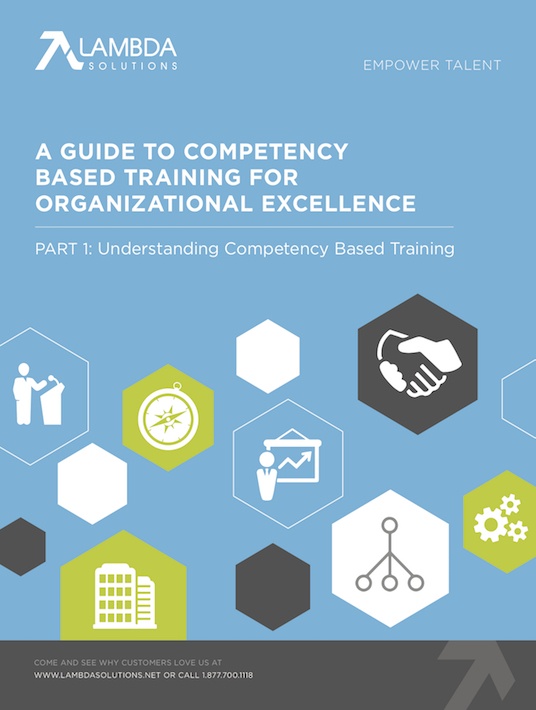Competency-Based Training (CBT): What It Is And Why You Should Consider It For Your Organization
Developing and maintaining a fully functioning competency-based training (CBT) program requires significant time and resources. It truly takes years for a dedicated team of HR and Learning and Development managers to create and deploy organization-wide competency-based training. But why does that happen? And what exactly is CBT?

What Is Competency-Based Training?
Before we define and explain competency-based training (CBT), let’s break it down to define ‘competency’. The term competency refers to individual characteristics that contribute to acceptable or outstanding performance[1]. Competencies can be anything from a set of knowledge, skills, behaviors, attitudes, and characteristics that lead to producing distinguished results[1]. Competencies lie at the core of successful performers so it is important to understand that the analysis of high-achieving talent is one way to identify competencies that allow success over others[1].
Breaking it down further, there are different categories of competencies such as functional competencies, personal competencies, and business competencies. Functional competencies are applicable technical knowledge or skills that are needed for a particular field or profession[2]. For example, accountants require different functional competencies than engineers or electricians. The second group of competencies is personal competencies, which are individual attitudes and skills required to maintain professional relationships and personally develop and learn. An example of a personal competency would be one’s communication skills or the ability to prioritize commitments. The final group of competencies is business competencies wherein individuals have the ability to view problems or situations through a business lens; for example, strategic or critical financial thinking[2].
What is competency-based training then? According to the National Skills Center of Australia, “competency-based training is a structured approach to training and assessment that is directed toward achieving specific outcomes. It is about assisting individuals to acquire skills and knowledge so they are able to perform a task to a specified standard under certain conditions”. Thus, in competency-based training, a performer’s expected outcomes must be clearly stated so that the learner knows exactly what is expected of them. Similarly for competency-based trainers, once competencies are assigned to learners, the trainer will know the precise training and learning that is required to bring the learner to the desired level of competency[3].
Bringing the aforementioned all together, organizational aim is then to create competency models for specific functional roles that contribute to company-wide strategic goals. Competency models are a set of typically 10-30 competencies that define the capabilities of successful performers[1]. To derive competency models it is key to focus on performers who have been highly successful in the roles for which competency models are created.
To do this, create profiles of exemplary performers and be sure to define their effectiveness based on measurable abilities and traits. Once competency models are created it is then easier to identify gaps in your talents’ behavioral or work outputs. Being able to identify these gaps is the first step in bringing talent to a level of competency that creates competitive advantage[1].
Why More Organizations Are Focusing On Competency-Based Training
More and more organizations are implementing competency-based training because it helps to prioritize training dollars and ultimately it achieves results[3]. Research tells us that some individuals are up to 20 times more productive than others[1]. If you could have your pick of these hyper-productive employees, wouldn’t you? Lucky for you, with competency-based training you can. When you match both individual competencies with job competency models you effectively put talent in positions where they will flourish[1]. Coupled with this, by simultaneously focusing on developing the employee’s competencies, you will come closer to closing the gap to the competency model so that the employee reaches his or her ultimate potential. When this happens the individual will have reached a level of self-actualization wherein benefit to the company continues to multiply. Here are additional reasons why organizations use competency-based training.
Competitive advantage is achieved for organizations who know characteristics that drive the best results because they are better positioned to recruit, select, develop, reward, and promote the most successful performers[1]. According to training experts Graber & Rothwell, “competencies are an important tool, much like a compass, to find direction in attracting, developing, retaining, and positioning the best, most productive and promotable people.”
Competencies Outlive Job Tasks
Since competencies are built around the characteristics of highly successful people, they outlive job descriptions and can be used by organizations to train and evaluate talent forever[1]. There will, of course, be times when competencies can be modified and added upon but their essence will remain virtually unchanged. Compared to job descriptions, competencies effectively center in on the particular characteristics of individuals that lead to success above their peers. Often, the unique characteristics that competency evaluations highlight are overlooked or ill-identified in job descriptions.
Competencies Support Organizational Capabilities
As we all know successful organizations have strategic capabilities that set them apart from their competition. This relates to competencies because, collectively, in order for an organization to excel at capabilities like innovation, low cost, and service—they need to possess certain competencies to thrive in these areas[1]. For example, if an organization’s strategy is to be a low-cost provider (e.g. Wal-mart), they will need to focus hiring efforts on competencies much different than an organization focused on exceptional service (e.g. Nordstrom).
4 Reasons Why Learning And Development Managers Love CBT
1. Competencies Target The Foundation
Competencies are often ingrained characteristics or traits that are built up over years of experience and training. Learning and Development managers find that successful performers don’t even realize they have them—those traits are so ingrained that they become second nature in one’s behavior and attitude. Thus, in order to understand successful performers at their core, Learning and Development managers have to spend significant time observing and probing these individuals to truly understand how they developed their core competencies over time. It has been found that most successful performers have attained their competencies through proactive measures such as: coaching and mentoring, networking, observing successful performers, joining problem-solving groups and communities of practice, and reading[1]. Aside from on the job training, Learning and Development managers can provide the aforementioned activities to further develop employee competencies.
2. The 70-20-10 Percent Competency Development Rule
The 70-20-10 percent competency rule suggests that 70% of competencies development happens on the job, 20% happens through networking either online or in person, and only 10% happens through programmed training[1]. For example, if seeking to improve an individual’s emotional intelligence competency, training is a small portion of the development path. The majority of the development plan is best spent working closely on a project with an employee or supervisor who demonstrates high emotional intelligence. By carefully observing the emotionally intelligent co-worker, the trainee can then set aside time for one-on-one conversations to delve deep insight into his or her observed subject’s cognitive and emotional process to gain further understanding.

Credit: Lambda Solutions
3. Competencies Define Organizational HR Needs To Achieve Strategic Outcomes
When companies complete organization-wide competency assessments, they are able to identify competency gaps that impede short and long-term strategic results. Once competency gaps are identified, HR professionals are positioned to make better decisions when it comes to recruitment, hiring, onboarding, performance management, compensation planning, and succession planning.
4. Competencies Provide Employees With Linear Or Non-linear Advancement Plans
When employees have a deep understanding of their strengths and weaknesses—the competencies where they are lag or excel—they are better able to focus their development efforts to improve their shortcomings. In future articles, we’ll discuss various methods to help employees gain insight into their competencies and areas for improvement. Once competency assessments are completed, managers are also equipped with extensive insight to discuss career paths and development plans so employees can advance in their careers and reach their highest potential.
Benefits Of Competency Modeling
Significant time and effort go into creating accurate and whole competency models. When done properly, organizations will benefit from the following[1]:
- Lower turnover due to high productivity and employee value alignment
- Ability to identify training gaps allowing for targeted training
- Facilitation of employee development through tailored individual development plans
- Creation of career paths for future positions
- Quicker and easier to the identification of candidates ready for promotion
- Competency-focused succession plans
- Development of workforce plans that meet future talent needs
References:
[1] William J. Rothwell and Jim M. Graber, Competency-Based Training Basics (New York: ASTD, 2010)
[2] http://learningdesigns.com/is-it-or-isnt-it-competency-based-training/
[3] https://www.k4health.org/sites/default/files/Guide to Writing Competency Based Training Materials.pdf







